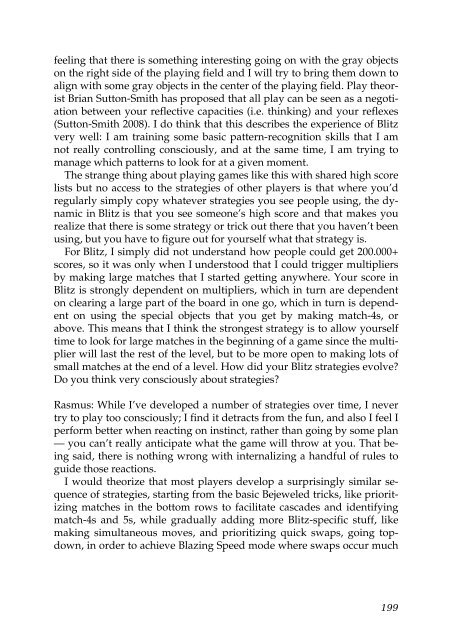Well Played 2.0: Video Games, Value and Meaning - OpenLibra
Well Played 2.0: Video Games, Value and Meaning - OpenLibra
Well Played 2.0: Video Games, Value and Meaning - OpenLibra
You also want an ePaper? Increase the reach of your titles
YUMPU automatically turns print PDFs into web optimized ePapers that Google loves.
feeling that there is something interesting going on with the gray objects<br />
on the right side of the playing field <strong>and</strong> I will try to bring them down to<br />
align with some gray objects in the center of the playing field. Play theorist<br />
Brian Sutton-Smith has proposed that all play can be seen as a negotiation<br />
between your reflective capacities (i.e. thinking) <strong>and</strong> your reflexes<br />
(Sutton-Smith 2008). I do think that this describes the experience of Blitz<br />
very well: I am training some basic pattern-recognition skills that I am<br />
not really controlling consciously, <strong>and</strong> at the same time, I am trying to<br />
manage which patterns to look for at a given moment.<br />
The strange thing about playing games like this with shared high score<br />
lists but no access to the strategies of other players is that where you’d<br />
regularly simply copy whatever strategies you see people using, the dynamic<br />
in Blitz is that you see someone’s high score <strong>and</strong> that makes you<br />
realize that there is some strategy or trick out there that you haven’t been<br />
using, but you have to figure out for yourself what that strategy is.<br />
For Blitz, I simply did not underst<strong>and</strong> how people could get 200.000+<br />
scores, so it was only when I understood that I could trigger multipliers<br />
by making large matches that I started getting anywhere. Your score in<br />
Blitz is strongly dependent on multipliers, which in turn are dependent<br />
on clearing a large part of the board in one go, which in turn is dependent<br />
on using the special objects that you get by making match-4s, or<br />
above. This means that I think the strongest strategy is to allow yourself<br />
time to look for large matches in the beginning of a game since the multiplier<br />
will last the rest of the level, but to be more open to making lots of<br />
small matches at the end of a level. How did your Blitz strategies evolve?<br />
Do you think very consciously about strategies?<br />
Rasmus: While I’ve developed a number of strategies over time, I never<br />
try to play too consciously; I find it detracts from the fun, <strong>and</strong> also I feel I<br />
perform better when reacting on instinct, rather than going by some plan<br />
— you can’t really anticipate what the game will throw at you. That being<br />
said, there is nothing wrong with internalizing a h<strong>and</strong>ful of rules to<br />
guide those reactions.<br />
I would theorize that most players develop a surprisingly similar sequence<br />
of strategies, starting from the basic Bejeweled tricks, like prioritizing<br />
matches in the bottom rows to facilitate cascades <strong>and</strong> identifying<br />
match-4s <strong>and</strong> 5s, while gradually adding more Blitz-specific stuff, like<br />
making simultaneous moves, <strong>and</strong> prioritizing quick swaps, going topdown,<br />
in order to achieve Blazing Speed mode where swaps occur much<br />
199

















